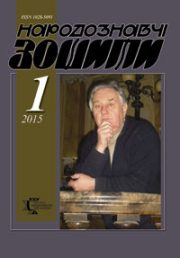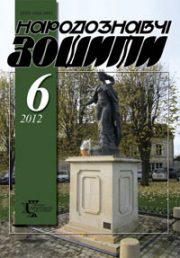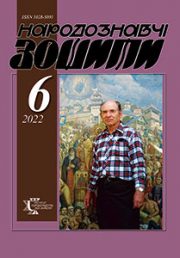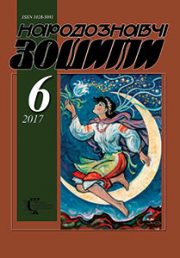The Ethnology Notebooks. 2018, 6 (144), 1589–1595
UDK 7.04. 029: 7 (477) “16-17”
DOI https://doi.org/10.15407/nz2018.06.1589
Received 21.11.2018
ORCID ID: https://orcid.org/0000-0002-0108-3317
Shyroka Оksana, Postgraduate student,
the Lviv National Academy of Arts,
38 Kubiiovycha Str., 79011, Lviv, Ukraine.
Contacts: Tel.: 0969319209, oksana.shiroka@gmail.com
Abstract. The article deals with the problems of the origin, structure and iconography of the Akathists of the Blessed Virgin Mary and Jesus Christ. Verseled texts of these two Akathists became the basis for their iconographic embodiment in the works of fine art. The general features of the structure and iconography are defined, the typology of the main motifs, plots and images of the Akathists of the Virgin and Christ based on examples of this iconography in the Ukrainian art of the XVII—XVIII centuries is singled out. The common and distinctive features of the structure and iconography of the Akathists of the Virgin Mary and Jesus Christ are analyzed. The influence of Western European art and theological literature on the Ukrainian iconography of the Akathists of the Virgin and Jesus Christ of the XVII—XVIII centuries was traced.
Keywords: Akathist of the Most Holy Mother of God, Akathist of Jesus Christ, kondak, icos, hayretism, praise of the Virgin.
REFERENCES
Akathist (1663). Kyiv, printing house of lavra. Vernadsky National Library of Ukraine. Kyiv, Kyr. 35. [Cyrillic script].
Akathists, Kyiv, printing house of lavra (1674). Vernadsky National Library of Ukraine. Kyiv, Kyr. 642 (2). [Cyrillic script].
Akathists with sticherons and canons. Kyiv, printing house of lavra. (1693). Vernadsky National Library of Ukraine. Kyiv, Kyr. 146 П [Cyrillic script].
Akathists with sticherons and canons (1699). Lviv, printing house of Brotherhood. Vernadsky National Library of Ukraine. Kyiv, Kyr. 637 [Cyrillic script].
Akathist to Virgin Mary (2010). Prayer book with psalter. Fourth edition, PW «Sviatogorec». Kiev ; Kharkiv ; Lviv [in Ukrainian].
Gromova, E.B. (2005). History of the Russian iconography of Akathis. Icon of «Praise of the Virgin with Akathist» from the Assumption Cathedral of the Moscow Kremlin. Moscow: Indryk [in Russian].
Yulian Katrii (2004). Know your rite. Third edition, corrected and supplemented. Lviv: Monastery of St. Ivanivska Lavra, Publishing Department Svichado [in Ukrainian].
Kozlov, M. (1989). Akathist as a genre of church hymns. Akathist (Vol. 1, pp. 3—12). Moscow: YMP. Burn this book [in Russian].
Kozhushnyi, O.B. Akathist to the Blessed Virgin and hayretisms, as a characteristic feature of this hymnographic genre. Bulletin of the Kiev University named after. T. Shevchenko (pp. 40—47). Kyiv [in Ukrainian].
Liudogovskyi, F.B. (2015). Structure and poetics of Church Slavonic Akathists. Moskow: Institute of Slavic Studies of RAS [in Russian].
Ovsiichuk, V.A., & Krvavych, D.P. (2001). The story about the icon. Simferopol: Tavrida [in Ukrainian].
Popadopulo-Keramevs, A. (1903). Akathist of the Mother of God: Rus and Patriarch Photius. Byzantine Provisional (Vol. 10, pp. 380—381). St. Petersburg [in Russian].
Petrovskyi, A.V. Orthodox Theological Encyclopedia. Attachment to the spiritual journal «Wanderer» (Vol. 1, A pillar. 37). Petrograd [in Russian].
Popov, A.V. (1903). Orthodox Russian akathists, published with the blessing of the Holy Synod. The history of their origin and censorship, features of content and construction. Church Literary Research. Kazan [in Russian].
Psalter with the Inquisition (1495). Psalterium ecclesiosslavicum, cum officiis diversis. Tsetyn: Printing house Dzhrdzha Tsrnoenovycha, typographer hieromonk Macarius [Cyrillic script].
Serebriakova, M.S. (1985). On the placement of akafis compositions in the north-western corner of the cathedral of the Ferapontov Monastery. TODRL (Vol. 38) [in Russian].
Samsonova, I.V., & Krasylnykova, M.Y. (2015). Akathist in the Orthodox cultural tradition. Мodern Research on Social Problems (electronic scientific journal), 2 (46) [in Russian].
Triodion. Kyiv, printing house of the laurels (1627). Vernadsky National Library of Ukraine. Kyiv, Kyr. 7 [Cyrillic script].
Filatov, V.V. (1997). Dictionary of the isograph. Moskow: Orthodox St. Tikhon Theological Institute [in Russian].
Shchepkina, M.V., I.S., Duicheva (Ed. with introductory article). (1963). Bulgarian miniature XIV centuries. The study of the Psalteri Tomic. Moscow: Iskustvo [in Russian].







